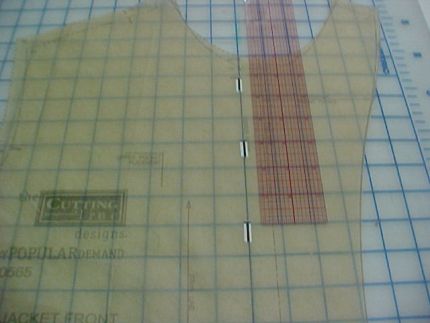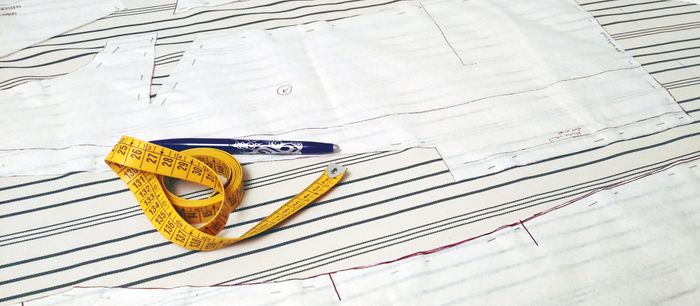
You may have purchased shirts that fit properly but still gap at the bustline. Even oversized garments can gap if the buttons are in the wrong place.
When making a garment, don’t make any markings for button or buttonholes until the garment is almost completed. In most of my ‘Cutting Line Design’ patterns, I don’t even indicate buttonhole placement, with a few exceptions dictated by construction. Make sure you have on the proper under garments you plan to wear and slip in shoulder pads if they are going to be worn when the garment is completed.
While standing in front of a mirror, slip the almost completed garment on and look carefully at where the apex of your bustline is located. The apex is the fullest pint of the bust. Place a pin at this point on the garment.
Lay the garment on a flat surface, and measure from the stitching line at the center front neckline to the pin placement along the center front line. On your pattern front, measure from the neck stitching line down the same distance and mark a line or dot.

To determine where other buttons must occur, such as the neckline, measure the distance from the button at the bust line to the button placement location at the neck.

Divide this distance in half. This placement will be if you want only one button between the bust and the neckline.

You can divide the distance into thirds if you want 2 buttons in between. Use this same distance for the button placement below the bustline along the center front of the garment.

If you are…
Start your 14-day FREE trial to access this story.
Start your FREE trial today and get instant access to this article plus access to all Threads Insider content.
Start Your Free TrialAlready an Insider? Log in






This is exactly what I have been doing for years.
Beautiful work. I want to try bound buttonholes now.
When ever the design allows, to prevent gapping also use horizontal rather than vertical placement of buttonholes to keep buttons from unbuttoning themselves, too.
Thank you so much for these invaluable tips! Really enjoy all the articles received from Threads!
I too, have been using this method for years. It is wonderful to wear a garment and not have to worry about gaping shirts. Thanks for all of your wonderful tips and illustrations.
Thanks for the advice. It really came at an opportune time as I was just starting a new wardrobe for the winter.
I must be stupid but I can not understand the first two directions.
"1.Lay the garment on a flat surface, and measure from the stitching line at the center front neckline to the pin placement along the center front line.2. On your pattern front, measure from the neck stitching line down the same distance and mark a line or dot."
Could you please make it clearer?
Thanks.
Judi
1.Lay the garment on a flat surface, and measure from the stitching line at the center front neckline to the pin placement along the center front line.2. On your pattern front, measure from the neck stitching line down the same distance and mark a line or dot.
I must be stupid but I don not understand these two instructions. Please make them clearer with actual examples and pics.
Thanks!
I'm with jraph1. Could you please clarify the first step? The only pin I can see you have put in is at the apex of the bust. Sorry, I'm confused.
I'm with jraph1. Could you please clarify the first step? The only pin I can see you have put in is at the apex of the bust. Sorry, I'm confused.
It aint rocket science! To put it simply -Having fitted the garment & pinned the front together, mark the bust point - draw a horizintal line across to CF & that is the first button position, If the waist is fitted - do the same, & put all other required buttons equidistant around these first two! Hope this simplifies any queries!
It was perfectly clear to me.
I'm just a novice but found your directions and photos perfectly clear. This is so helpful, especially to a beginner!
Thank you so much!
I also figured this out, decades ago. Being short waisted, most things gaped at the bust, the buttons being placed for longer torsos; one reason I began to sew my own clothes. I could see horizontal b'holes would hold better, but since vertical holes are so often required, I found a technique that would keep them closed. Don't remember if I worked this out myself or read it somewhere, I've been using it so long. As you mark button placement, make sure the button centres are at the very top of the b'hole. I lap the plackets over, as they will be when worn, making sure the hems and necklines are even. Stick a pin through each b'hole at the very top, as straight as you can. Mark where the pin goes thru the button placket. If the marks don't line up vertically, straighten the line. It's the horizontal position of the marks you can't change. Sew on each button making sure the upper button threads will rest at the top of the b'hole, but not so tight that they distort it. For example, with a four hole button, the top two holes should be at the b'hole top. I fasten each button after I stitch it, testing to see the threads are snugged up tight, but not so much as to cause a wrinkle. I check for evenness at the neck and hems after each button is done up. If anything is off,I cut off the button and do it again, until each one is exact. When I put the garment on, I tug the b'hole placket down, from the placket hem, while tugging the placket with the buttons on it up from the neck. This tugging sets each button perfectly into place. Assuming buttons and holes are correctly sized for each other, they won't come undone on their own. At least, hasn't happened yet to any of mine.
To fix ready made things, for small buttons,I sometimes shorten b'holes with a stitch or two at one end, or replace with bigger buttons. I'll reattach buttons to correct their placement, so they stay closed. Once or twice I've added extra buttonholes to shirts, often quite close together, to get one that's properly placed to stop gaping. I use new buttons, usually a different colour than what the shirt came with, so minor differences in the b'hole thread or stitches aren't very obvious. You can place extra holes above and/or below existing ones, usually one will work to close the gap. When done, it will look like the shirt was meant to have buttons grouped in pairs, threes, or even fours. Don't forget to make matching changes on the cuffs, if needed.
Sorry this got so long !
So sorry for the confusion. To find where the first button is place on an almost completed garment:
1. Put the garment on standing in front of a mirror
2. Place a pin at Center Front at the fullest part of your bust. This is where the most improtant buttonhole will be sewn.
3. Decided where you want the button at the top of the center front will be. Place a pin there.
4. Fold the garment matching the 2 pins. The fold line inbetween the 2 pins will be where the next pin(and buttonhole) will be.
5. Measure the distance between 2 of the pins, then below the bust pin placement, put additional pins down the center front to indicate where all the buttonholes will be sewn.
If you want the buttons and buttonholes closer together, divided the distance between the bust pin and neckline pin by 3...this will give you the placement for 2 buttonholes to be spaced equal distance between the bust and neckline. Using this same measurement that you now have between pins, measure down the center front for the additional buttonhole placement.
Yes, when at all possible try to sew horizontal buttonholes. This helps from having a garment accidently pop open. Vertical buttonholes are used when making a shirt with a vertical tab along the front.
Hope this helps, Sincerely, Louise
This is a great tip.
Thanks for sharing.
This is a great tip.
Thanks for sharing.
Thanks for giving me "permission" to change the spacing.